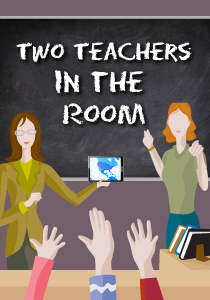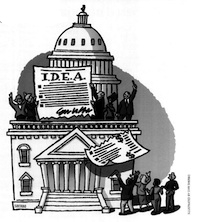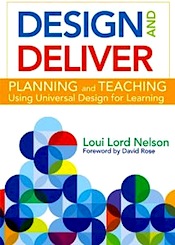We Have the Power to Move Inclusion Forward
A MiddleWeb Blog
 I am all for change. In fact, I completely embrace it. I marvel at the fact that it is only by changing things that we can make some part of our world a better place. It is through positive change that we become a better version of ourselves.
I am all for change. In fact, I completely embrace it. I marvel at the fact that it is only by changing things that we can make some part of our world a better place. It is through positive change that we become a better version of ourselves.
Yet, positive change doesn’t just happen because a law is passed or a policy is approved. We have to follow through, keep the spark alive, and take actions over time to make what we say we want to happen really be successful. Inclusive education is a good example. Inclusion is one of those evolving changes that can both empower and frustrate us.
I am personally empowered by the potential that inclusive education can initiate. When implemented with integrity, inclusion can energize educators, students, and parents, leading to individual triumphs that also can build successful communities of learners.
That’s the potential. But I am also frustrated by the treadmill that many districts walk on when it comes to improving the inclusive practices in their schools. This treadmill approach creates a situation for inclusion to produce wonders in some classrooms, but not in others. If inclusion is going to work for all students, across all schools, more consistent follow through and updating need to be in place.
Let’s put the issue into historical perspective
For a comprehensive description of the history of inclusive education in the United States, check out this article. Take a minute now to journey through past decades. Be prepared to be amazed that this evolving and necessary change to improve the education for all students began over 35 years ago!

In the over 20 years that I have been a special education teacher, I cannot look back and recall one workshop—one faculty meeting—or one conference day that was devoted to the topic of teacher collaboration in inclusion classrooms. Master schedules are set each year to incorporate so many important factors in the educational life of our schools —but never have I seen attention placed on ensuring that co-teachers have common planning time in their schedules.

So how can we bring more teachers onboard?
So how do we get more teachers onboard to make inclusion work? Here’s my off-the- top-of-my-head list of do’s and don’ts that can help us move inclusion forward.
1. To general education teachers: share your plans—do not expect your co-teacher to just come to class and see what the lesson is about at the same time the students find out! Share your plans ahead of time, so that the special education teacher can be proactive with best practices and accommodations for strategic, meaningful learning for all of your students.
2. To special education teachers: get savvy with the content—do your homework– while holding on to the fact that you must insert your expert knowledge in the process of learning.
3. To general education teachers: expect that in your inclusion classroom you will need to implement instruction differently and collaboratively—you do not have to teach each class the same way for all students.
4. To special education teachers: take the necessary baby steps to bring awareness of best practices that work well for all students—see the CAST website for surefire approaches to meeting the needs of ALL students.
5. To general education teachers: remember that the special education teacher is there to teach WITH you to benefit the students—he or she is not there to make your life easier. So it’s not about the special education teacher grading papers to take a bit of the load off for you (although that’s part of the plan). He or she is not there to teach the class so you can take a break (that’s never part of the plan). He or she is there to share, to learn, and to teach alongside you—together as one. Here’s a must read by Anne Beninghof about how co-teaching is not about taking turns—but about teaching collaboratively. Read it and then discuss your thoughts with your co-teacher.

Some book ideas: Any book by Anne Beninghof, any book by Marilyn Friend. And here’s a new one that I just ordered and am so excited to read and share with colleagues: Design and Deliver: Planning and Teaching Using Universal Design for Learning, by Loui Lord Nelson.
7. To general education teachers: You must adopt a “we” mindset as you speak to the class. You are teaching with another teacher in the room. Be mindful of your language. Are you territorial? Notice whether or not you are sending welcoming messages to your co-teacher and your students about how you really feel about co-teaching.
8. To all teachers: Keep an open mind, don’t take anything the other teacher does personally, and embrace the talents that each of you bring to the classroom—it’s all for the students!
9. To all teachers: Remember that one person cannot do it alone. We need each other. If one co-teacher is striving for successful implementation, but the other teacher is stuck in a world of “all about me” then, well—you know how this story will end.
And so we see that although professional development, administrative support, and common planning time are all very important and necessary—what really matters is how the two teachers in the room are approaching the experience. It all comes down to the mindsets, attitudes, and willingness to work together—no matter what!
So what are you doing to make inclusion work? What would you add to my list of do’s and don’ts? Can we take my ideas and your ideas and make a New Year’s Resolution to take charge and move inclusion forward again?



































My city’s school district is not embracing inclusion which I find very sad
Hi, Linda, are you still able to find ways to collaborate with colleagues? Perhaps you can create some co-teaching lessons by combining classes? Are there any opportunities for collaborative efforts?
Perhaps there are some building level or classroom level options you may consider?
Thanks for sharing. Are you a special educator or general educator? Let us know!
Yes, but I will also add that the inclusion collaboration involves not only the GE and SE teachers, but also the students, families, administrators, related staff providers, and everyone else who believes and plans for successful school and life outcomes.
Toby, yes! It is as though you read my first draft for this post! There are so many variables involved in creating positive inclusive settings. Thank you for pushing the discussion along here. I narrowed the focus down to the classroom scene for this post, but your insights are so meaningful. Please continue to share your thoughts…and maybe we can craft another blog post!
Would love to hear your role in educating students…I am looking forward to hearing more of your insights and experiences!
All the Best!
I just had this exact conversation with administration at my school. Thank you so much for expressing this possibility for successful co-teaching so clearly and succinctly. I can see a path through trees…..
Michelle, thanks for sharing! I am so thrilled to hear that you are creating a clear path–I, too, am working on this same path. It’s great to know there are many path-makers out there! Please share some more details–would love to hear about your experiences, hopes, and realities. All the best!
I hear all the time from general ed teachers that they could teach their classes in their sleep, they’ve done it for so long. But the general ed classroom today is not the same as it was even five years ago, we are seeing increasing numbers of students with more and more varying challenges, so I worry about all the students, that they’re not getting the attention they need in this inclusive environment. I like your point number three, that we need to change our methods so that we don’t teach each class the same way. It would be nice if we could get people to change their mind set to be more inclusive. Baby steps, though, huh?
Eileen, thanks for adding your voice here. It’s so true…not only are classrooms today so different from year to year, but they are different from class to class! Individual thinkers sit in each class–and their individual minds deserve to be valued and nurtured.
Yes, we have to move strategically, so we continue to move forward. I am focused on the fact that one day–one of our baby steps will land us on solid ground!
So many thanks for your thoughtful comment. I hope you continue to come back and share your insights and experiences.
All the best!
I co-teach in one of my ELA classrooms and it works wonderful for our inclusion model … but the reality is that it works only because the two of us work hard to find time to connect. There is no built-in meeting time during the week for my co-teacher and I to plan, share, collaborate. It works because we mesh well and know each other. But if he left and another co-teacher came into place, it has all the makings of a potentially difficult time. Our district believes in inclusion but has not gone out of its way to find time for teachers to plan to make it work. In fact, during many PD days, our special education colleagues are often separated from us (I know, the irony) instead of learning along with us on how to make our classrooms stronger for all students.
Kevin
Hey, Kevin! Your story really confirms the fact that inclusion works when both teachers are open to it–and also have a history of working together. I’d like to think that if your co-teacher was plucked out of the scene and you were each placed with different co-teachers, you would be able to replicate the secret of success again. This secret to success has to be more than just two personalities eager to make it work. And I strongly believe it’s possible to create a new awareness and reality of consistency for more co-teachers.
Your PD experience is true from my perspective as well. Although, my district does create a merging of gen. ed. and spec. ed. but I fear that the spec. ed. teachers still feel like they are just shuffled through the gen. ed. scene. Many become detached rather than combine their expertise into the PD experience. We’re working on that as well! Moving forward…stories like yours can inspire…thanks for sharing!
Hello Elizabeth,
I am a fourth year teacher and this is my first year in a new district. This is the first year they’re implementing an (almost) full inclusion model and I’m a special educator working with one grade level. I’ve found your blog very inspiring and it has helped to keep me motivated to make this model work, and I’ve seen it work in other districts! Unfortunately, here, I’ve found my working relationship with one general educator to be much stronger than with the others and that’s been the hardest part so far. Being new to the school and relatively young I haven’t felt that my ideas have been embraced in the other classrooms and I continue to play a supportive role (very frustrating). I want what’s best for these students but continue to struggle at building a positive working relationship with teachers that seem to feel as if I’ve invaded their space. I want to remain positive but am definitely feeling disheartened since we’re this far into the school year and the progress has been extremely slow.
Jennifer, I am so glad that my blog is a place that you can count on for inspiration. I am always inspired by the comments that push my thinking along. Having meaningful dialogue about real-life experiences is the only way we will find solutions. Thanks so much for your comment!
I (along with so many teachers) can easily connect to your experience. I find that as long as I focus on what’s best for students, my energy is redirected into what I can do for the kids. Yes, it is discouraging and tiring to strive for positive co-teaching relationships. Knocking walls down that others may build is just such a waste of energy–yet, it must be done. If one co-teacher is really not open to sharing, you can only do what you can do. You know you cannot change anyone, so do what you can. Find all the possible ways for you to reach your students. Try to call a team meeting with your co-teachers to get on the same page. The rest will fall into place. The best inclusion experiences happen when there is ongoing professional development and administrative supports–seek out your resources in your building. Perhaps there are other co-teachers you can collaborate with–I like that you are staying positive–you must–your students need you! Keep us posted. Please find me on Twitter, and let’s keep seeking solutions! Join my bi-monthly chat #coteachat and feel connected to other dedicated teachers. Hope to connect soon. All the best!